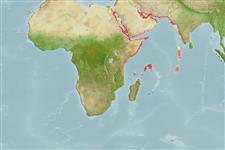Common names from other countries
>
Kurtiformes (Nurseryfishes, cardinalfishes.) >
Apogonidae (Cardinalfishes) > Apogoninae
Etymology: Cheilodipterus: Greek, cheilos = lip + Greek, di = two + Greek, pteryx = fin (Ref. 45335).
More on author: Rüppell.
Environment: milieu / climate zone / depth range / distribution range
Écologie
marin démersal; profondeur 1 - 50 m (Ref. 127989). Tropical; 30°N - 10°S
Western Indian Ocean: Red Sea, Gulf of Oman, and the Persian Gulf.
Taille / Poids / Âge
Maturity: Lm ? range ? - ? cm
Max length : 8.0 cm TL mâle / non sexé; (Ref. 11441)
Color in life silvery gray with 4 black stripes. 5th stripe runs along anal-fin base, continues anteriorly to pelvic-fin base, at which point it curves upward to reach in front of pectoral-fin base. The part of this stripe anterior to anal-fin base is often indistinct. A black oval spot at middle of caudal peduncle encircled by a yellow area. A distinct black spot on dorsal surface of caudal peduncle. Area between yellow pigment and this spot appears as distinct white mark. Fins pale (Ref 8525).
Common in shallow protected water, sheltering among the spines of Diadema sea-urchins in groups of up to about 30 individuals (number depends on the size of the urchin and the length of the fish). Maximum depth reported taken from Ref. 127989.
Life cycle and mating behavior
Maturities | Reproduction | Spawnings | Egg(s) | Fecundities | Larves
Mouthbrooders (Ref. 240). Distinct pairing during courtship and spawning (Ref. 205).
Gon, O., 1993. Revision of the cardinalfish genus Cheilodipterus (Perciformes: Apogonidae), with description of five new species. Indo-Pac. Fish. (22):59 p. (Ref. 8525)
Statut dans la liste rouge de l'IUCN (Ref. 130435)
CITES (Ref. 128078)
Not Evaluated
Menace pour l'homme
Harmless
Utilisations par l'homme
Outils
Articles particuliers
Télécharger en XML
Sources Internet
Estimates based on models
Preferred temperature (Ref.
115969): 25.1 - 29.2, mean 27.6 (based on 348 cells).
Phylogenetic diversity index (Ref.
82804): PD
50 = 0.5000 [Uniqueness, from 0.5 = low to 2.0 = high].
Bayesian length-weight: a=0.01122 (0.00528 - 0.02384), b=3.10 (2.92 - 3.28), in cm Total Length, based on LWR estimates for this (Sub)family-body shape (Ref.
93245).
Niveau trophique (Ref.
69278): 3.7 ±0.6 se; based on size and trophs of closest relatives
Résilience (Ref.
120179): Haut, temps minimum de doublement de population inférieur à 15 mois (Preliminary K or Fecundity.).
Fishing Vulnerability (Ref.
59153): Low vulnerability (10 of 100).
